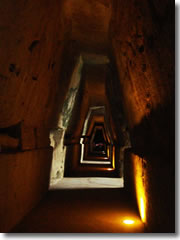- Places
- Plans
- Itineraries
- Experiences

The Cave of the Cumean Sibyl.The Sibyls were the greatest fortunetellers of the ancient world, and one of the most famous was here at Cuma, a city founded in 1050 BC and therefore competing with Sicily's Siracusa for history book status as the oldest Greek colony in Italy.
Cumae was so widely regarded as a cultural center that the local alphabet was adopted as the official one for Latin, and hence our modern one.
The town itself was largely destroyed in the 9th century by the Saracens—who had little regard for grammar. But the cave where the Sibyl sat and spoke her oracles was rediscovered in 1932 near a mountaintop.
This Cave of the Cumean Sibyl (Antro della Sibilla) hewn out of the tufa consists of a 131.5-meter-long corridor (434 feet) in the shape of an angular, trapezoidal keyhole some 5m (16.5 feet) high and, at the widest spot, 2.4m (8 feet) across.
It runs due north-south and is pierced at regular intervals on the west side by short tunnels to the outside that provide light. The Sibyl sat in the rectangular room at the end.
The archaeological park (tel. +39-081-854-3060, cir.campania.beniculturali.it/archeocuma) that contains the cave is an evocative spot, with sweeping panoramas and the paltry remains of several temples under bougainvillea and shade trees.
After you consult the oracle in her cave, take the path up to the mountaintop to drink in the vistas and see the brick arches that remain of the Temple of Jupiter.
The Cuma park open daily 9am to an hour before sunset.
 Many of the Cumean Sybil's predictions and advice dealt with the Underworld, which is why Aeneas came here to ask her how he could travel to Hades and speak with his dead father (Virgil's Aeneid, book VI).
Many of the Cumean Sybil's predictions and advice dealt with the Underworld, which is why Aeneas came here to ask her how he could travel to Hades and speak with his dead father (Virgil's Aeneid, book VI).
This is not surprising, considering that the gateway to Hell happens to be just down the road under the Lago d'Averno, or Lake Avernus.
This round little lake cupped in the crater of an extinct volcano is some 5 miles around and over 100 feet deep.
It's enough just to glimpse the famed pool as you swing past on the bus between Cuma to Pozzuoli. But if you've got your own wheels, you might want to get out and explore the unenclosed site.
At the east shore of the lake are the ruins of a baths complex (called Tempio di Apollo for no apparent reason), and on the northwest shore the ruined entrance to the Grotta della Pace, a wide tunnel built by the Roman general Agrippa in the 1st century BC.
Until World War II bombs destroyed part of it, you could follow this tunnel all the way to Cuma. It was part of an elaborate defensive system designed by Agrippa which included digging canals to connect Lago d'Averno with the sea and create a protected naval harbor (all destroyed by the earthquakes that accompanied the 1538 eruption of Monte Nuovo).
Campi Flegrei Tourist Info:
Largo Matteotti 1A, Pozzuoli
tel. +39-081-526-6639
www.infocampiflegrei.it
or
www.coopculture.it
To get to Cuma, take the CTP bus no. P12 from Via Roma in Pozzuoli (tel. +39-081-526-5321, www.ctpn.it), or the SEPSA bus from Baia (tel. +39-081-735-4965; www.sepsa.it). Both let you off near the site entrance.
For tickets, you can get a Unico Napoli ticket for €3.10 that lasts all day and covers pretty much all of this region—or get the Artecard sightseeing pass, detailed below.
Note: The decrepit "Circumflegrea" rail line that runs inland around the Campi Flegrei from Naples Montesanto—forming the northern half of a shaky rail circle around the area (the Cumana rail line forms the southern, coastal half)—in some years does not even stop at the Cuma station, and at any rate the station is a long, long walk from the main site entrance (and the site entrance nearest the station is open only at 10:15am and again at 12:15am, open again as an exit only at 12:15pm and 2:15pm). Crazy. My advice: Just use the buses.
There are two versions of the Campania sightseeing pass that covers this area: Napoli e Campi Flegrei (€16 for three days; 3 sights free, the rest half-off; and all public transport) and Archeologia del Golfo (€30 for 3 days; all sights—including all the ones here [except Solfatara], plus Pompeii, Herculaneum, the Naples Archaeological Museum, and more; and all public transport). Since the sights of the Campi Flegrei are all covered on a single, €4 ticket (again, except privately-run Solfatara), if you get that first pass I'd actually use the 3 freebies for pricier marquee sights in Naples—but you still get 50% off your Phlegrean Fields ticket, plus that invaluable free bus/Metro pass. For details: www.campaniartecard.it.
The closest tourist office is in Pozzuoli at Largo Matteotti 1A (tel. +39-081-526-6639; www.infocampiflegrei.it). Their administrative office is at Via Campi Flegrei 3 (tel. +39-081-526-1481). Most of the basics on open hours, admission, etc. are also covered on the Campania Artecard site (www.campaniartecard.it). Also hit the regional information site for Campania: www.incampania.com.
Share this page
Search ReidsItaly.com
Campi Flegrei Tourist Info:
Largo Matteotti 1A, Pozzuoli
tel. +39-081-526-6639
www.infocampiflegrei.it
or
www.coopculture.it